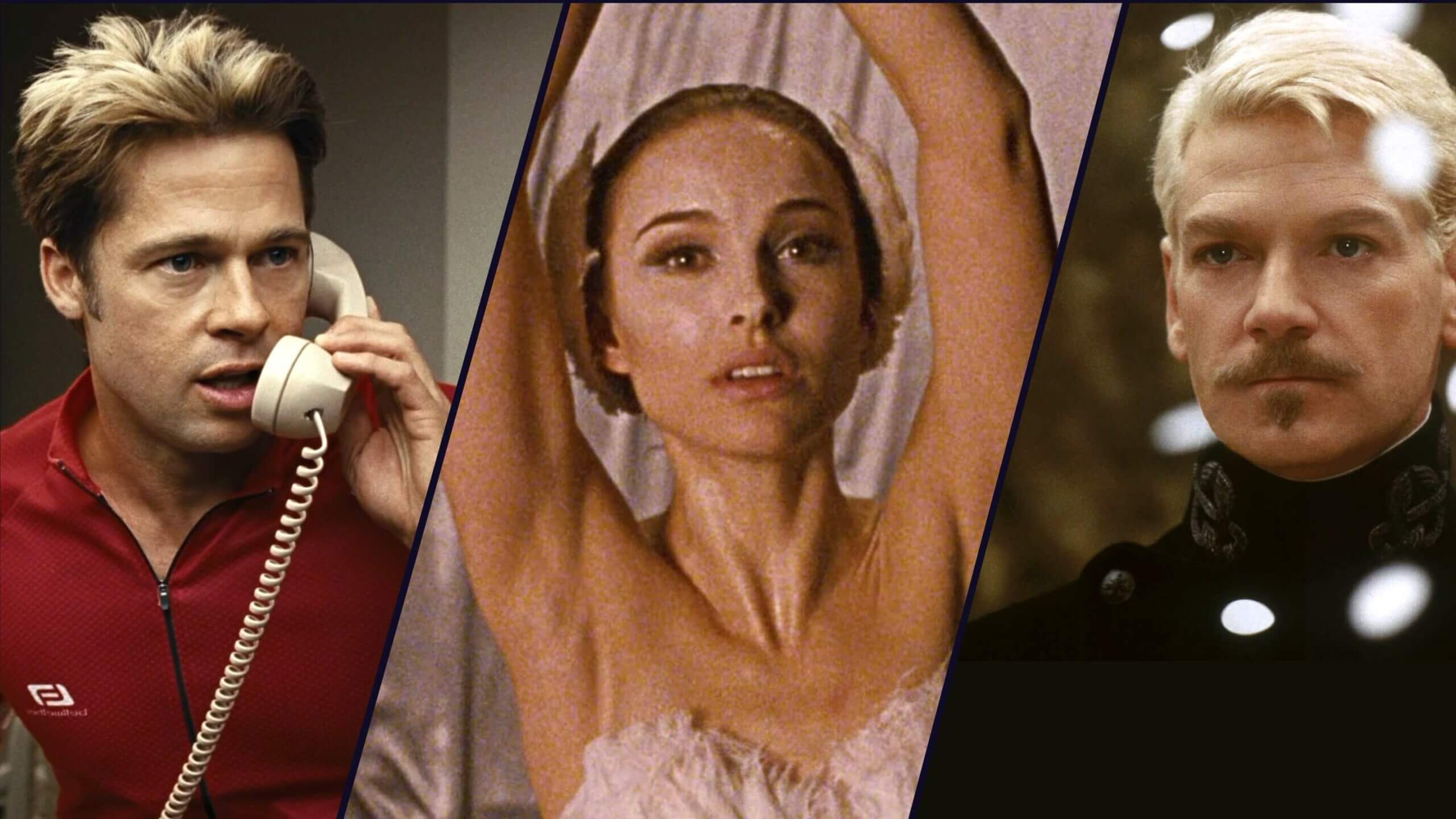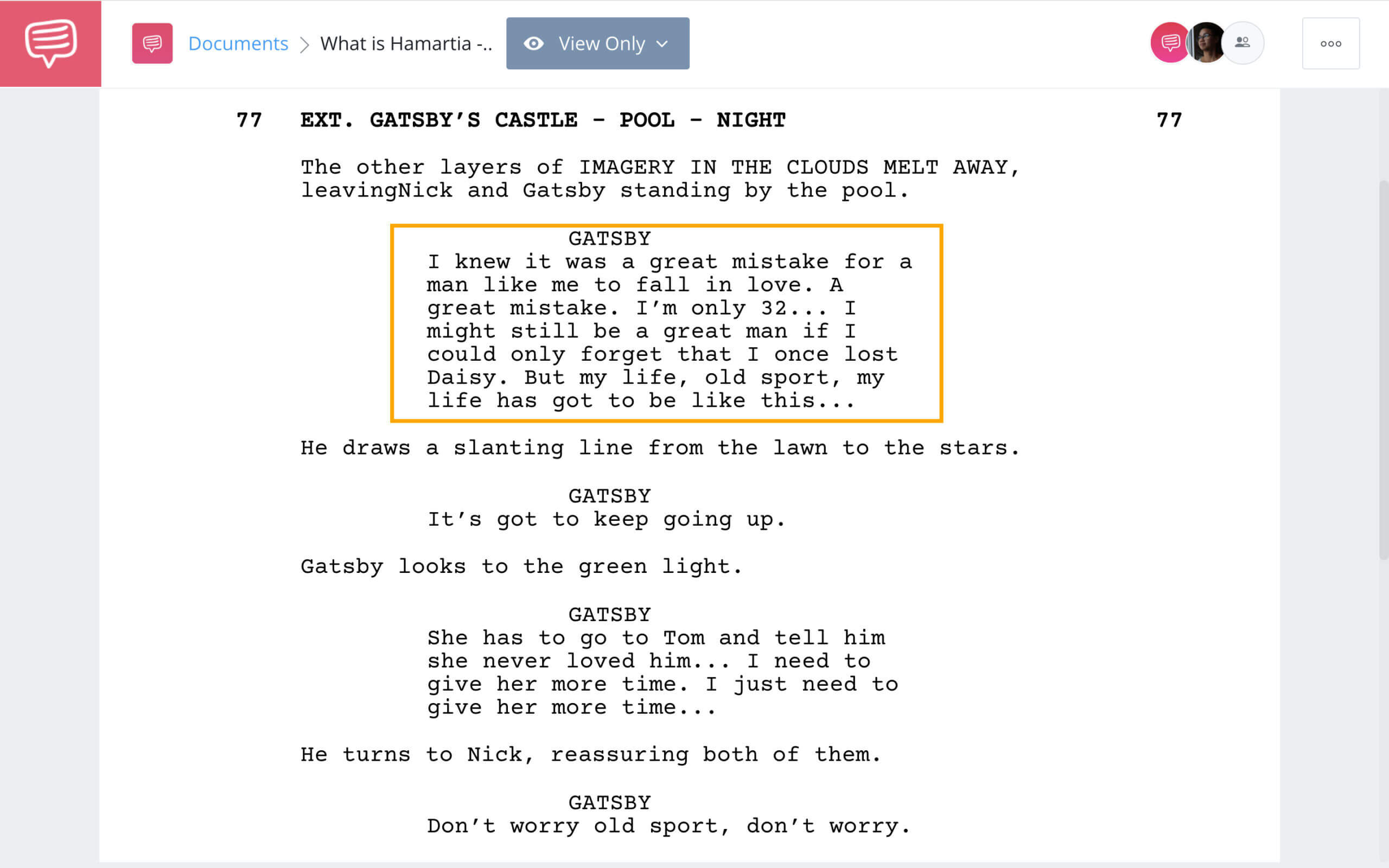The most striking characters in film have detailed, complicated character traits. On occasion, our heroes succumb to the power of their most wicked flaws. Hamartia is a timeless term that describes this failure. If you haven’t heard of hamartia before, don’t sweat it. We’ll unpack how to spot hamartia and utilize it in your own work. So, what is hamartia and how does it work? Let’s find out.
What is Hamartia?
First, let’s define hamartia
Strong protagonists have clear intentions and face threatening obstacles. But a critical component to an interesting protagonist is the flaw they must confront in order to achieve their goal.
When a character is unable to overcome their flaw, that is where the term hamartia comes into play. So let’s find out: what is hamartia?
HAMARTIA DEFINITION
What is Hamartia?
Hamartia is a fatal flaw leading to the downfall of a tragic hero. Hamartia derives from the Greek term meaning “to miss the mark” or “to err.” First used by Aristotle in Poetics, hamartia, commonly referred to as the tragic flaw, often sets off a chain of events which culminates in a reversal from fortune or good standing to disaster or catastrophe.
Hamartia Pronunciation: huh-MAR-tee-uh
Hamartia examples:
- Ruben in Sound of Metal
- Maggie in Million Dollar Baby
- Jackson Maine in A Star is Born
Origins of Hamartia
Discover the roots of hamartia
Hamartia comes from the greek word hamartanein, meaning “to err.” It denotes an inherent defect within the character themselves, rather than one that the tragic hero has come upon while on their journey.
Aristotle first coined the term in Poetics when he described a character who was not defeated by an opposing or malicious force, but by their own error in judgment. Often this downfall is catastrophic for the hero and their society.
Aristotle’s portrayal of hamartia sets the bar for tragic characters in that the flaw is often excessive and blatant. Think of the classic literary term hubris; disproportionate pride topples the tragic hero’s life around them. Regardless of the moral being abused, we can define hamartia similarly: as a hero acts on their flawed judgment, their potential for success snowballs into destruction.
Related Posts
Classic Hamartia Examples
Early hamartia examples
Literature, film, and entertainment in general have incorporated the idea of the hamartia over centuries. Being that film is a comparatively new medium of storytelling, it stands to reason that you can find classic examples of hamartia in written works.
One of the clearest examples of hamartia can be found in Oedipus Rex. The titular character is plagued with a simple tragic flaw throughout the story: a lack of knowledge. He doesn’t know that he is the son of King Laius and Queen Jocasta.
This ignorance propels the plot and Oedipus’s downfall. As an infant, Laius hears a prophecy that Oedipus will kill him. To avoid this, Laius gives Oedipus away. Oedipus grows up believing he has different parents, and when he hears from an Oracle that he is doomed to kill his father and marry his mother, he runs away from his adopted parents.

Oedipus leaving Corinth
Oedipus ends up back in his hometown, and inadvertently kills his real father, not knowing who he is. He then runs into his real mother, and marries her.
When the truth finally comes to light, Oedipus gouges his eyes out. All of this happens because of his hamartia– he didn’t know who his real parents were.
Hamlet is another iconic example of hamartia in action. In Shakespeare’s famous play, Hamlet is tasked with killing the man who murdered his father. But at every turn, Hamlet is paralyzed with doubt and indecision– his hamartia.
This fatal flaw results in tragedy– Hamlet kills the wrong man, resulting in his lover’s suicide. By the time Hamlet finally kills the right guy, it’s too late. Nearly everyone he loves is dead.
Like Oedipus Rex, this hamartia propels the play forward. If Hamlet didn’t have the tragic flaw of indecision, the play would be a whole lot shorter with a significantly lower body count.
As Gatsby nears his life goals, his unharnessed determination threatens his success, and his hamartia leads to the loss of Daisy, the death of two supporting characters, and even his own murder.
MODERN HAMARTIA EXAMPLES
Hamartia in today’s films
Hamartia is a timeless story-telling tool. It gives audiences a reason to support the hero, but also to question how the hero’s story will end. These conflicting notions lead to drama and tension, and today’s filmmakers have modernized that dramatic hamartia in relatable ways.
There are a number of great examples of how hamartia is used in films and TV today: In Breaking Bad, Walter White has hubris. Hubris leads to his family falling apart, his ally, Jesse’s mental deterioration, and his own defeat; he never overcomes his hamartia.
Another example is in Marie Antoinette: Marie Antoinette’s hamartia lies in her greed and selfishness, and it also leads to her death.
One early example of hamartia comes from The Great Gatsby. In the novel and films, tragedy is born of the protagonist’s hamartia, ambition; Gatsby will stop at nothing to repeat his past. His ambition drives him to engage in mysterious business dealings, and he throws massive and extravagant parties in order to lure Daisy Buchanan, the long lost love of his life, to his home.
We imported the script into StudioBinder’s screenwriting software to pinpoint Gatsby’s fatal flaw.
The Great Gatsby • Gatsby’s looks to the green light • Read Full Scene
In The Great Gatsby, it is also worth noting that Gatsby’s hamartia comes from his childhood experiences of being poor; his hamartia is deeply ingrained. In this video, director Baz Luhrmann shares the importance of Gatsby’s youth and how it has led to his current state of being, including his final flaw.
Baz Luhrmann discusses Gatsby’s ambition
As Gatsby nears his life goals, his unharnessed determination threatens his success, and his hamartia leads to the loss of Daisy, the death of two supporting characters, and even his own murder.
Another particularly striking example of hamartia in more recent films is that of Harvey Dent in The Dark Knight. What’s especially interesting about Dent is that his flaw, devotion to justice, is one most would consider a strength. He sees things as all or nothing, black or white, one thing or another; in addition, his claim to “fame” is Gotham.
Check out the below crash course on Harvey Dent’s character arc, where in a supercut of pivotal beats, Dent’s “all or nothing” mentality truly comes to light.
What Does Hamartia Mean for Harvey Dent? • The Rise and Fall of Harvey Dent
From this breakdown, it’s evident that Dent’s strength also causes his demise: he seeks revenge after taking his false dichotomy to the extreme, and it damages himself and those around him. Dent becomes a villain once his hamartia has totally overtaken him.
Another modern hamartia example that can help us define hamartia is Ruben in Sound of Metal. Driven by denial, Ruben’s character cannot accept his deafness. He makes active decisions to reject his condition, going so far as to sell all of his personal belongings to pay for a cochlear implant surgery.
Ruben believes that simply refusing to change will allow his life to continue as normal. Ruben’s hamartia (denial) causes him to lose all of his physical possessions, Joe/the deaf community to lose faith and trust in him, and his relationship with Lou to crumble. Watch the video below to see a breakdown of how Ruben moves through this series of losses.
Hamartia Examples in Sound of Metal • Ruben finds himself through loss
This instance of hamartia is striking because while Ruben’s flaw causes his peers and himself damage, he does eventually find peace… but not until after everything has fallen apart around him. As the video above mentions: Ruben finds himself through loss.
When his implant does not work as he imagines and he loses his girlfriend and supportive peers, there is nothing left for Ruben to do but bear witness to his own consequences, face his deafness, and accept his authentic self.
One could also argue that Ruben’s addictive behavior is a fatal flaw, as he becomes addicted to his need for the cochlear implant and to return to Lou (of course, there is also the literal manifestation of this as he struggles with sobriety). Ultimately, Ruben’s addictions still boil down to refusal of the present moment, and the result is the same as these iterations of his hamartia run parallel throughout the film.
Related Posts
How to Use Hamartia
Use hamartia in your own work
Hamartia is a powerful tool to use in your characters… but not necessarily all of them. Here are some tips for creating hamartia:
Keep it Simple
Your tragic hero should be the main (if not only) character with hamartia. This will keep the plot progression focused on that character’s journey with a fully realized catharsis.
Build Character
Use hamartia to build the character, but also to guide their journey. Where they come from can connect to and even be the cause of their hamartia; where your hero comes from can inform where they go.
The Prime Obstacle
Implement hamartia as an obstacle on their journey, but not as the journey itself. Build the character’s life around the flaw. What makes their hamartia so damaging? How does it lead to demise? Other facets of the hero’s life should have their own decline in order to mirror the hero’s harmful behavior.
External Consequences
Stories with hamartia typically end in death and general destruction, but hamartia can lead to destruction of life around your hero, as well. It can be just as much of a downfall for your hero to witness consequences of their actions than to go down with the ship.
Hamartia can damage the hero, but it presents an opportunity for meaningful growth within your hero, too. In instilling a profound sense of self (or lack thereof) for your protagonist, you can build a stronger foundation for your story from the get-go.
Related Posts
UP NEXT
How Writers Develop Strong Characters
Now that you’ve discovered hamartia, what other elements can you incorporate to create robust characters? Delve into what character development means, get started on the free worksheet, and build stronger characters now.

